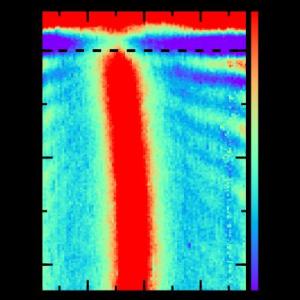ICFO scientists in collaboration with members of the EU Graphene Flagship and Columbia University, have proved that graphene combined with boron nitrides insulating power will enable light control. This has been achieved by exploiting plasmons in which light and electrons move together as a single coherent wave.
 This image shows simulation and observations of propagating plasmons in boron nitride heterostructure. Credit: ICFO
This image shows simulation and observations of propagating plasmons in boron nitride heterostructure. Credit: ICFO
By exploiting plasmons, the electrons and light move together in one coherent wave. These plasmons can be confined to length scales of nanometers. Until now, an major hurdle has been the rapid energy loss experienced by these plasmons restricting the range over which they can travel. Researchers have now proposed a solution to this issue and ICFO(Barcelona) researchers have partnered with CIC nanoGUNE (San Sebastian), and CNR/Scuola Normale Superiore (Pisa) ,all members of the EU Graphene Flagship, and Columbia University (New York).
After graphene was discovered, several other 2D materials have been isolated in the laboratory. One example is boron nitride, which is a very good insulator. Combining these two distinct 2D materials has offered a solution for controlling light in small circuits and suppressing losses. Encapsulating graphene in boron nitride helps electrons to move ballistically without scattering for long distances even at room temperature.
It is remarkable that we make light move more than 150 times slower than the speed of light, and at lengthscales more than 150 times smaller than the wavelength of light. In combination with the all-electrical capability to control nanoscale optical circuits, one can envision very exciting opportunities for applications.
Professor Frank Koppens from ICFO
The research conducted by PhD students Achim Woessner (ICFO) and Yuando Gao (Columbia) and postdoctoral fellow Mark Lundeberg (ICFO), is only the commencement of several discoveries on nano-optoelectronic characteristics of new heterostructures based on integrating different kinds of 2D materials. Researchers at Columbia University first discovered the material heterostructure.
Boron nitride has proven to be the ideal 'partner' for graphene, and this amazing combination of materials continues to surprise us with its outstanding performance in many areas.
Professor James Hone
Now we can squeeze light and at the same time make it propagate over significant distances through nanoscale materials. In the future, low-loss graphene plasmons could make signal processing and computing much faster, and optical sensing more efficient.
Prof. Rainer Hillenbrand from CIC nanoGUNE
Theoretical studies were also done by the research team. Marco Polini, from CNR/Scuola Normale Superiore (Pisa) and the IIT Graphene Labs (Genova), formulated a theory and did calculations along with his collaborators. He comments that "according to theory, the interactions between light, electrons and the material system are now very well understood, even at a fully microscopic level. It is very rare to find a material that is so clean and in which this level of understanding is possible".
These findings enable highly miniaturized optical circuits and devices, which could be beneficial for optical and/or biological sensing, information processing or data communications.
References